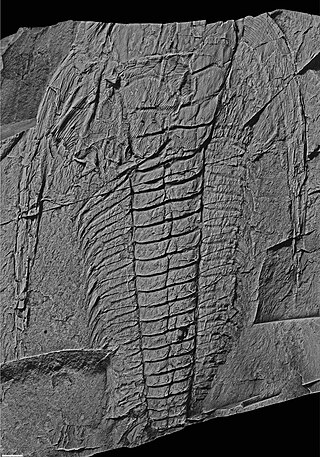
John William Salter was an English naturalist, geologist, and palaeontologist.
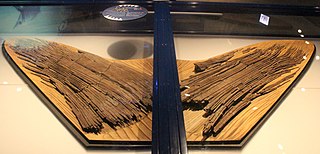
Leedsichthys is an extinct genus of pachycormid fish that lived in the oceans of the Middle to Late Jurassic. It is the largest ray-finned fish, and amongst the largest fish known to have ever existed.
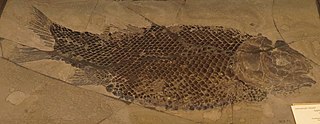
Lepidotes is an extinct genus of Mesozoic ray-finned fish. It has long been considered a wastebasket taxon, characterised by "general features, such as thick rhomboid scales and, for most of the species, by semi-tritorial or strongly tritorial dentition". with dozens of species assigned to it. Fossils attributed to Lepidotes have been found in Jurassic and Cretaceous rocks worldwide. It has been argued that Lepidotes should be restricted to species closely related to the type species L. gigas, which are only known from the Early Jurassic of Western and Central Europe, with most other species being not closely related, with other species transferred to new genera such as Scheenstia.Lepidotes belongs to Ginglymodi, a clade of fish whose only living representatives are the gars (Lepisosteidae). The type species L. gigas and close relatives are thought to be members of the family Lepidotidae, part of the order Lepisosteiformes within Ginglymodi, with other species occupying various other positions within Ginglymodi.
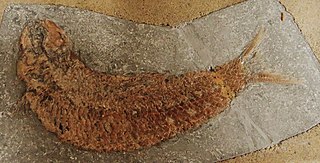
Pholidophorus is an extinct genus of stem-teleost fish. Numerous species were assigned to this genus in the past, but only the type species Pholidophorus latiusculus, from the Late Triassic of Europe, is considered to be a valid member of the genus today.

Protosphyraena is a fossil genus of swordfish-like marine fish, that thrived worldwide during the Cretaceous period (Albian-Maastrichtian). Fossil remains of this taxon are mainly discovered in North America and Europe, and potential specimens are also known from Asia, Africa and Australia. Its fossils are best known from the Smoky Hill Member of the Niobrara Chalk Formation of Kansas.

Holostei is a group of ray-finned bony fish. It is divided into two major clades, the Halecomorphi, represented by the single living genus, Amia with two species, the bowfins, as well as the Ginglymodi, the sole living representatives being the gars (Lepisosteidae), represented by seven living species in two genera. The earliest members of the clade, which are putative "semionotiforms" such as Acentrophorus and Archaeolepidotus, are known from the Middle to Late Permian and are among the earliest known neopterygians.
Paleontology or palaeontology is the study of prehistoric life forms on Earth through the examination of plant and animal fossils. This includes the study of body fossils, tracks (ichnites), burrows, cast-off parts, fossilised feces (coprolites), palynomorphs and chemical residues. Because humans have encountered fossils for millennia, paleontology has a long history both before and after becoming formalized as a science. This article records significant discoveries and events related to paleontology that occurred or were published in the year 1977.
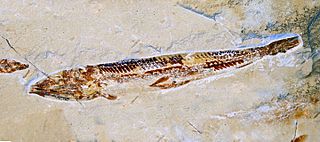
Prionolepis is a genus of prehistoric ray-finned fish belonging to the order Alepisauriformes.
Leslie Reginald Cox FRS was an English palaeontologist and malacologist.

Aphanepygus is an extinct genus of prehistoric marine holostean ray-finned fish that lived during the upper Cenomanian. It inhabited the former Tethys Ocean, with remains known from Lebanon and Croatia. Its exact affinities are uncertain, although it is usually recovered as a relative of the macrosemiids. However, other authorities recover it in the Ionoscopiformes.
Aphnelepis is an extinct genus of prehistoric freshwater ray-finned fish that lived during the Late Jurassic epoch. It contains a single species, A. australis, from the Talbragar River beds of New South Wales, Australia.
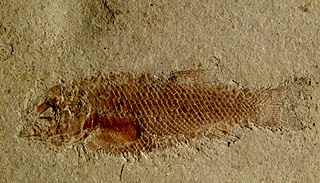
Acentrophorus is an extinct genus of prehistoric freshwater and marine ray-finned fish from the Roadian to the Wuchiapingian of England, Germany (Kupferschiefer), Italy and Russia. There may also be a Triassic occurrence in Australia.
Clupavus is an extinct genus of marine ray-finned fish that lived during the middle of the Cretaceous period. It is known from North Africa, Europe, Brazil, and possibly North America.
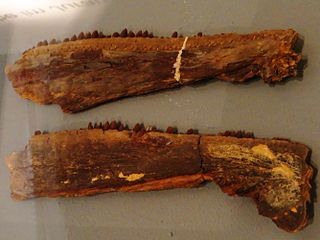
Saurocephalus is an extinct genus of ray-finned fishes within the family Saurodontidae. The genus was first described in 1824 and contains six or seven species, including the type species S. lanciformis. Saurocephalus first appeared during the early Valanginian and continued on to the Maastrichtian, where it nearly went extinct. However, the recent discovery of S. lanciformis remains from the earliest Paleocene indicates that it just barely survived into the Cenozoic. This would make it the last surviving ichthyodectiform.

Hulettia is an extinct genus of ray-finned fish known from United States. This fish genus contains two species, H. americana and H. hawesi.
The Triassic Lockatong Formation is a mapped bedrock unit in Pennsylvania, New Jersey, and New York. It is named after the Lockatong Creek in Hunterdon County, New Jersey.

Fish are very diverse animals and can be categorised in many ways. Although most fish species have probably been discovered and described, about 250 new ones are still discovered every year. According to FishBase about 34,800 species of fish had been described as of February 2022, which is more than the combined total of all other vertebrate species: mammals, amphibians, reptiles and birds.

The Charmouth Mudstone Formation is a geological formation in England, dating to the Early Jurassic (Sinemurian–Pliensbachian). It forms part of the lower Lias Group. It is most prominently exposed at its type locality in cliff section between Lyme Regis and Charmouth but onshore it extends northwards to Market Weighton, Yorkshire, and in the subsurface of the East Midlands Shelf and Wessex Basin. The formation is notable for its fossils, including those of ammonites and marine reptiles and rare dinosaur remains. The formation played a prominent role in the history of early paleontology, with its Lyme Regis-Charmouth exposure being frequented by fossil collectors including Mary Anning.

Libotonius is an extinct genus of percopsiform fish which lived during the early Eocene epoch and contains two species, the type species Libotonius blakeburnensis plus Libotonius pearsoni. Libotonius has been variously treated as part of the expanded Percopsidae family, or formerly as a member of the monotypic family Libotoniidae.















